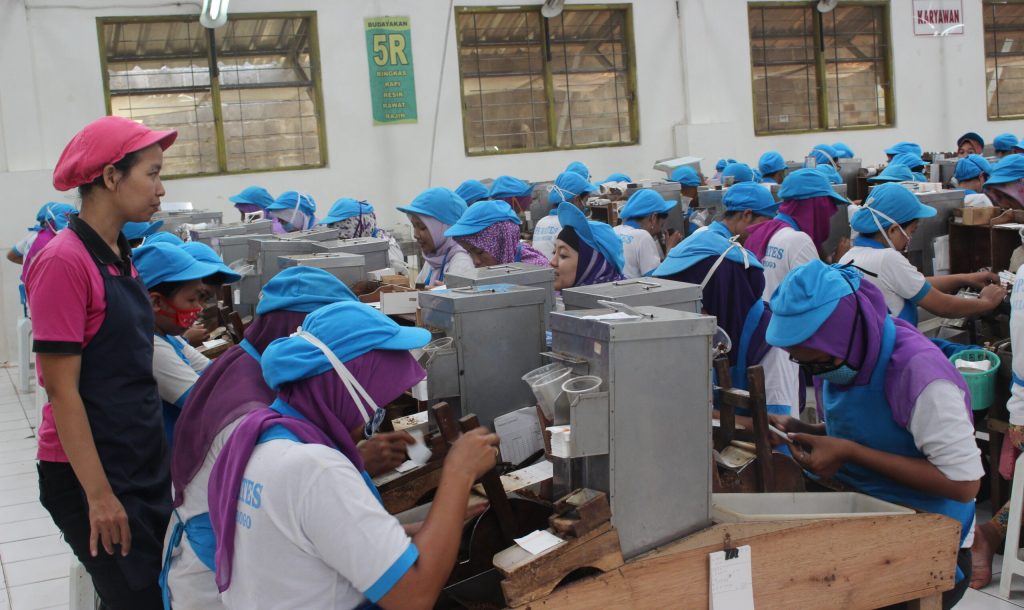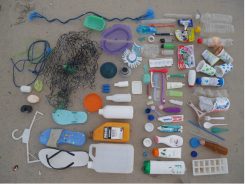When I walked my seven-year-old twins to their school in the East Java city of Malang, we sometimes made a game of counting the cigarette ads we passed during our ten-minute journey. The day in 2016 when we tallied fifty-eight one way, they would have passed over a hundred cigarette ads round trip.
We spotted four-metre banners adorning shops, signs erected on poles, and more modestly sized stickers that I also counted. If cigarette companies made these stickers, hired people to post them, and paid taxes on them, then they were surely effective in recruiting smokers. Sticker ads often appear at young children’s eye level, and tobacco control scholars have documented how tobacco companies work across the global south—including Indonesia—to ensure that cigarettes are widely sold near schools.

A marketing contractor attaches cigarette ads to a stall (author photo)
The dominant position cigarette ads command in Indonesian public space raise questions of tobacco justice and labour that were central to my research on Indonesia’s cigarette market. This market—the world’s second largest—is striking for its size, unique product composition, and gender disparities. Before the Covid-19 pandemic hit, Indonesians were smoking over 300 billion cigarettes a year. 95% of cigarettes sold in Indonesia are laced with cloves and called kretek, which onomatopoeically evokes the crackling sound they make when clove fragments ignite. So-called white cigarettes (rokok putih) without cloves make up only 5% of the market. In a country where about two out of three men smoke, boys and men experience social pressure to demonstrate adult masculinity by smoking. Girls and women are discouraged from smoking but exposed to environmental smoke in the majority of homes and workplaces.
My research focused on Sampoerna, Indonesia’s largest clove cigarette company, which was founded in 1913 by Liem Seeng Tee, a Chinese migrant. The company was primarily owned and operated by Liem’s descendants until Philip Morris International (PMI) acquired it in 2005. My recent book Kretek Capitalism shows that the cigarette industry in Indonesia is sustained through an extraordinary amount of paid and unpaid labour on the part of employees, contractors, retailers, community groups, artists, influencers, and consumers.
To understand the profoundly consequential relationship between Indonesians and these lethal commodities, I look beyond the “pull” of nicotine desire and addiction to examine the relentless “push” of predatory capitalism and the labour exploitation that undergirds it. I show that Sampoerna goes to great lengths to enlist and orchestrate this labour and to make it seem meaningful and fulfilling to those who perform it, even when its ultimate purpose is increasing company profits. Some of the jobs that kretek capitalism creates are stable, pay well, and offer opportunities for advancement and upward mobility in Indonesia’s difficult labour market. But a great deal of kretek capitalist labour is partial, seasonal, contract, low-paying, or unpaid.
Tobacco control versus commodity nationalism
From a public health perspective, the tobacco epidemic unleashes unnecessary and unjust suffering in Indonesia. Tobacco-related diseases claim an estimated 290,000 Indonesian lives each year, over 50,000 of which are attributable to second-hand smoke exposure. In Indonesian households where the father smokes, tobacco accounts for 22% of average weekly household expenditures, crowding out spending on food, education, and health care, contributing to high rates of child malnutrition and stunting, and diminishing health and economic life chances. People in Indonesia’s lowest income bracket smoke at twice the rate of Indonesians in the highest income bracket, implying that the poor bear the greatest burden of tobacco-related disease and risk of financial devastation due to chronic illness and the premature death of key household providers.
But Indonesia’s tobacco control advocates are resource-poor and politically weak compared to the wealthy, powerful, and entrenched industry, which insists that tobacco is a vital source of employment and tax revenue, overlooking government losses and expenditures as tobacco-related diseases diminish productivity and create high treatment costs in Indonesia’s single payer health system, BPJS Kesehatan.
Industry supporters often emphasise that kretek hold not only economic but also cultural significance. Because the commodity combines the New World crop of tobacco with cloves, indigenous to the “Spice Islands” of Maluku, and a brew of flavourants known as saus (sauce), proponents claim that it represents uniquely Indonesian cultural heritage. Commodity nationalists frame smoking kretek as a patriotic act that benefits the nation and links fellow citizen–consumers, creating national communion through consumption.
Coffee table books, industry- and government-sponsored kretek museums, and Netflix’s recent adaptation of Ratih Kumala’s novel Gadis Kretek, or Cigarette Girl, promote this perspective by romanticising and aestheticising the industry and soft-pedalling its harms. Kretek nationalist discourse and nostalgia focuses on the hand-rolled kretek and the women workers who make this charismatic commodity and figure as iconic and endangered by tobacco control. In the post-Suharto era of democratic transition and reformasi, it has become expedient for the industry to cultivate grassroots groups that purport to represent such workers alongside tobacco and clove farmers, vendors, and smokers who insist on the industry’s economic and cultural significance.
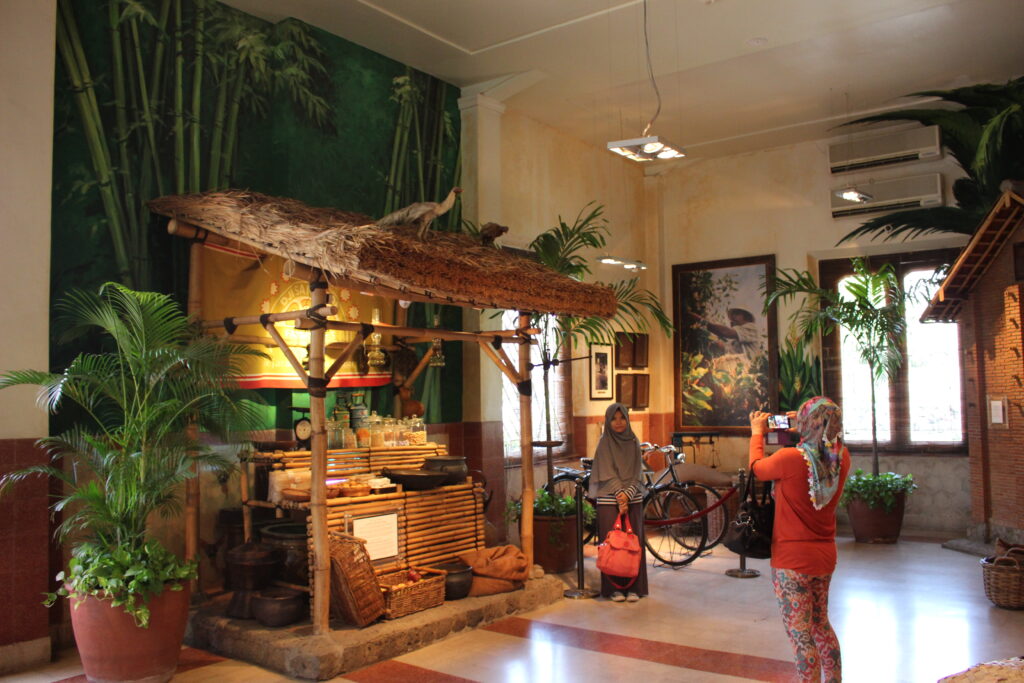
A diorama in the House of Sampoerna museum recalls the modest early years of family business (author photo)
The organisation Komunitas Kretek (Kretek Community or Komtek) cultivates a more militant kretek nationalism. Its website, social media, and downloadable books serve as a clearing house for product reviews and brand endorsements for the beginning smoker, odes to smoking rituals and to the “little people” whose livelihoods depend on the industry, challenges to the scientific consensus that tobacco is addictive and harmful, and claims that the kretek is not a cigarette and may cure rather than cause diseases like cancer.
Komtek associates the commodity with positive sentiments like love, affection, pleasure, and pride, but also mobilises negative sentiments including suspicion and hatred towards those who criticise the kretek industry. Komtek portrays domestic tobacco control activists, who have faced death threats, as national traitors and colonial lackeys. Foreign tobacco control organisations figure as neocolonial agents aiming to usurp Indonesian sovereignty and suppress indigenous industry, with Michael Bloomberg singled out for antisemitic depictions and accusations that his ulterior motive is selling nicotine replacement products. Komtek enhances commodity nationalism’s potency by pitching it as not only pro-kretek but also anti-colonial.
Kretek nationalist depictions of the industry typically gloss over its dominance by a small number of companies that achieved staggering market success by adopting global Big Tobacco technologies. The Indonesian cigarette market was dominated by white cigarettes through the 1960s. Over the 1970s and 1980s, the four largest kretek manufacturers—Bentoel, Gudang Garam, Djarum, and Sampoerna—imported European machines and mechanised kretek production. They marketed the new machine-rolled kretek as combining Indonesian taste (cloves and saus) alongside white cigarette features associated with modernity, prestige, and quality control that made them appear less harmful than unfiltered hand-rolled kretek, which were stigmatised as low class, coarse, dirty, and cheap.
By the 1990s, the four large kretek manufacturers, all of which were owned by ethnic Chinese Indonesian families, controlled around 80% of the industry and produced the majority of their cigarettes in mechanised factories. A number of Indonesia’s wealthiest billionaires and oligarchs made their fortunes in tobacco, including Putera Sampoerna, Djarum’s Hartono brothers, and Gudang Garam’s Susilo Wonowidjojo (Bentoel was part of Peter Sondakh’s Rajawali Corpora from 1991 until British American Tobacco acquired the company in 2009).
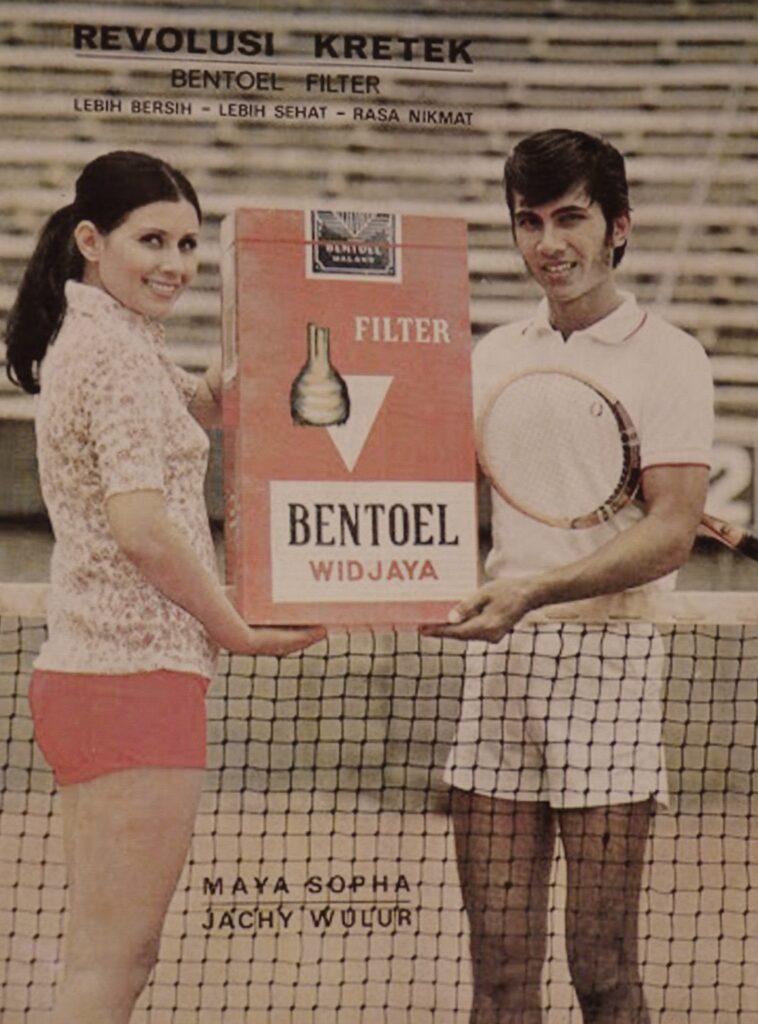
A vintage Bentoel ad promotes machine-rolled kretek as “cleaner” and “healthier” (author photo)
The success of Indonesian firms in marginalising white cigarette producers eventually led the latter to acquire kretek companies and “indigenise.” Tobacco control activists claim that Indonesia’s refusal to sign and ratify the World Health Organization’s 2003 Framework Convention on Tobacco Control (FCTC) helped motivate PMI’s acquisition of Sampoerna. After British American Tobacco and Japan Tobacco International followed suit by acquiring kretek firms, foreign firms assumed control over 40% of the Indonesian cigarette market.
Kretek companies drew on Big Tobacco’s deceptive product engineering (e.g. synthetic filters that turn brown when smoked and cigarettes that yield low tar and nicotine readings when machine evaluated) and marketing strategies (e.g. “light” or “mild” brand descriptors and pastel and pale metallic palettes) to make kretek appear safer and thereby perpetuate uptake and continuity of lethal commodity consumption. While producers have applied cutting-edge global technologies to the kretek, they have also relied on cultural heritage to market the industry as artisanal, traditional, and employment generating, working to ensure that the hand-rolled kretek, which claims only 20% of the market, looms large in the public imagination.
Labouring for kretek capitalism
The urge to protect employment opportunities in a country that suffers from un(der)employment and surplus labour is understandable. The Indonesian cigarette industry generates thousands of jobs and economic opportunities, especially in the tobacco producing and manufacturing regions of Java.
The industry’s drive to constantly mechanise and increase efficiency across the commodity chain, however, has the effect of reducing wage labour opportunities even when production levels are maintained or increased. European rolling machines that churn out 10,000 to 20,000 cigarettes a minute trivialise the feats of human cigarette rollers who make 300 to 600 an hour. Tobacco is mechanised both in the fields where it is grown and in the factories where it is processed, with stems and dust that would formerly have been waste converted into reconstituted tobacco (“recon”). Whereas hand-rolled kretek weigh two grams, machine-rolled kretek contain one gram or less and often incorporate puffed tobacco (made from leaves saturated with freon and ammonia gases and then freeze-dried) that enables producers to make more cigarettes with less tobacco.
The plastipelago
Indonesia’s encounter with the “plasticene” has led to a naïve and hasty government effort to rebrand waste as an asset.
I encountered widespread ambivalence among tobacco and clove farmers over whether their crops were sufficiently profitable to justify ongoing investment, and all were engaged in additional enterprises and crop production to make ends meet. World Bank studies have found high levels of poverty, poor housing, food insecurity, and reliance on government benefits among tobacco and clove farmers, and they attribute Indonesia’s import of 30–40% of the tobacco it consumes to the fact that farming is an insufficiently lucrative endeavour. In tobacco-growing regions cigarette companies primarily market budget brands—except during harvest when they briefly hawk expensive (“premium”) brands to rapidly relieve farmers of their newfound cash.

Women workers hoe a farmer’s tobacco field (author photo)
Sampoerna jobs in both hand-rolled and machine-rolled factories are coveted for their relatively high salaries and benefits, but the work itself is physically and mentally demanding and beset by tensions over contracting. Feminised hand-rolling factory workers are subject to punishing piecework quotas that produce stress and cumulative injuries. Workers with limited access to formal education and job opportunities appreciate high levels of take-home pay when factories require overtime but quickly find their household finances precarious in its absence.
Over the past three decades, Sampoerna has increasingly relied on contractors in lower minimum wage regions where workers must meet higher quotas for lower pay. Since 2014, Sampoerna has closed three of its own hand rolling factories, laid off thousands of workers, and reduced the contracts of its 38 “Third Party Operators.” Mechanised factories offer competitive salaries, benefits, and training opportunities but also subject their workers—who are hierarchised as contractors, daily workers, and monthly workers—to draining around-the-clock shift schedules, noise exposure and other factory hazards, and relentless pressure to “continuously improve” their quantity, quality, and safety performance.
Cigarette companies also recruit a considerable amount of labour—some of which is uncompensated—to promote their products and collect data on potential consumers. Sampoerna circumvents restrictions on directly promoting cigarettes through social media by hiring event organisers, influencers, and brand ambassadors to create hashtags, irresistible selfie walls, and competitions with prizes that require participants to register (yielding personal data including identity card, mobile phone number, social media accounts, and favourite cigarette brands) and post relevant content on platforms like Instagram. These efforts are particularly focused on youth and work through campus hobby groups, café and bar sponsorships, and amateur and professional music and art events.

A cigarette Sales Promotion Girl interacts with a potential customer (author photo)
Sampoerna’s marketing staff and contractors also extract shelf and advertising space and labour from the millions of independent retailers who reach into urban kampungs and remote highlands with commodities like instant noodles, soap, and cigarettes. Cigarette companies incentivise independent retailers to sell and advertise their products with “free” packs and competitions that prod them to create large pack displays or sell single sticks, all of which helps create the advertising-saturated and tobacco-friendly environment I described at the outset. Sampoerna has recruited over 243,000 independent retailers as “Sampoerna Retail Community” (SRC) partners that it encourages to modernise and promote its product. The company took advantage of the Covid-era demand for contactless shopping to expand the SRC “digital business ecosystem”, which is meant to generate more retail traffic and consumer data.
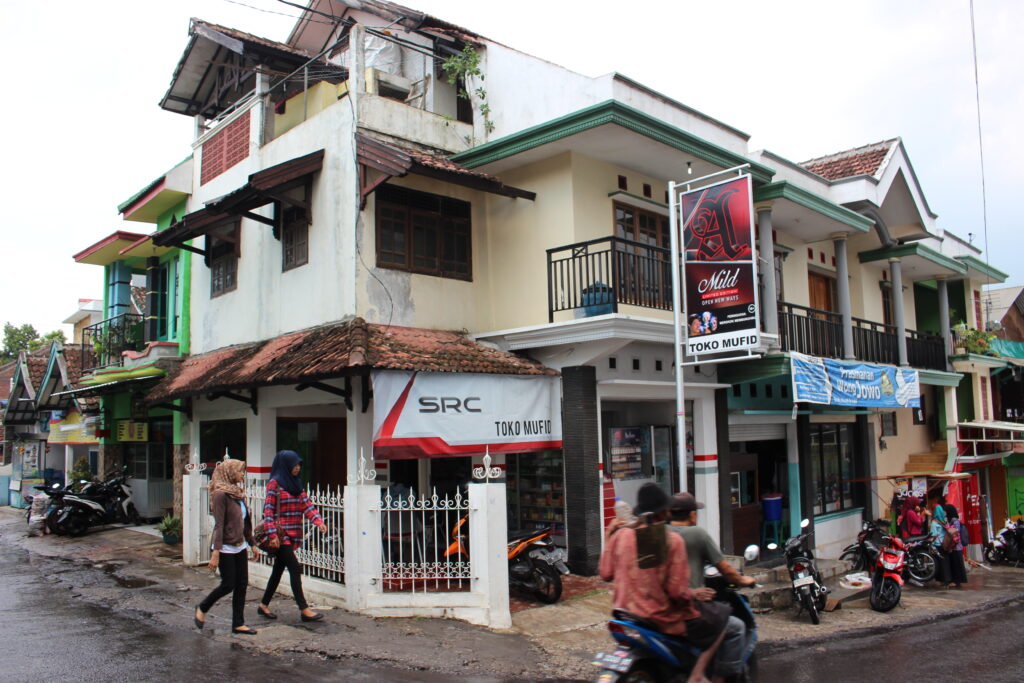
A Sampoerna Retail Community shop strategically located near a university (author photo)
Conclusion
Sampoerna remains Indonesia’s largest cigarette producer, although the Covid-19 pandemic and subsequent government tax policies have weakened its market position. Indonesia’s cigarette market has rebounded considerably from its initial Covid decline (from almost 306 billion sticks in 2019 to 276 billion in 2020), but Sampoerna’s market share has fallen from 32.2% in 2019 to around 28% as smokers switched to lower-priced brands in the face of lower income and government excise tax hikes on the largest cigarette producers.
With Sampoerna, Philip Morris International has maintained its dominance over the white cigarette, “low-tar” machine-rolled kretek, and hand-rolled kretek market sectors, while also setting its sights on controlling the nascent “reduced-risk” nicotine product sector. In late 2022, the company began producing “smoke-free” HEETS tobacco products at its new $186 million plant in Karawang, and it has been marketing these heat-rather-than-combust products along with the IQOS device in Indonesia.
Public health researchers have expressed concern that new nicotine-containing products, like “light” cigarettes in the past, contain hidden health risks, are used to recruit youth consumers rather than facilitate smoking cessation, and perpetuate addiction among “dual users.” Juul, whose potent nicotine salt formula and aggressive youth marketing on social media led to a teen vaping epidemic in the United States and inspired Philip Morris’ parent company Altria to acquire a 35% stake in the company for US$12.8 billion, stands as a stark cautionary tale. But for now, the reduced-risk sector remains a thin slice of the industry, especially in low- and middle-income countries like Indonesia.
Indonesians live neither in the fictionalised and romanticised past depicted by kretek nationalists nor in the equally imaginative and deceptive smoke-free future that the tobacco industry itself promises to deliver. In contemporary, actually existing kretek capitalism, a significant share of the industry is controlled by foreign firms, kretek are mostly machine-rolled, the poorest smoke the most, and tobacco control activists struggle for influence in a context where policy decisions are shaped by patriarchal sympathy with male smokers and friendly relations between industry and government.
 Facebook
Facebook  Twitter
Twitter  Soundcloud
Soundcloud  Youtube
Youtube  Rss
Rss 